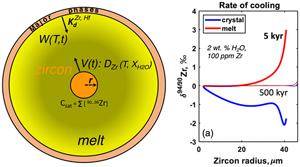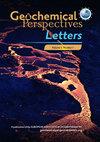The rises and falls of zirconium isotopes during zircon crystallisation
IF 3.7
1区 地球科学
Q1 GEOCHEMISTRY & GEOPHYSICS
引用次数: 0
Abstract
Zircon trace element and isotopic analysis for an increasing number of isotopic systems provide valuable insights into magma crystallisation, and evolution of the continental crust. Zirconium stable isotopes have been measured recently and shown to vary by several per mille on Earth. Both positive and negative shifts of δ94/90Zr have been found in zircons and melts, and equilibrium isotopic fractionations are found to be small. We here employ and further develop a zircon crystallisation programme with two moving boundaries targeting zircon crystallisation in the presence of other minerals. We reproduce positive, negative, and inverse δ94/90Zr, Zr/Hf, and other compatible trace element variations in zircon and surrounding melt that can be entirely explained by the boundary layer processes during kinetics of zircon crystallisation in a realistic set of geologic conditions. Progressively lower δ94/90Zr values in zircon develop during rapid crystallisation, lower melt water contents, crystallisation in the lower temperature range, and whilst co-crystallising with the Zr-poor phase. Given large (multi-per mille) kinetic Zr isotope fractionations discovered, zircon may serve as a monitor of magmatic crystallisation conditions, but is unlikely to serve as a diagnostic tool for the bigger set of petrological problems (e.g., evolution of the continental crust) without proper context.

锆石结晶过程中锆同位素的上升和下降
越来越多的同位素系统的锆石微量元素和同位素分析为岩浆结晶和大陆地壳演化提供了有价值的见解。最近对锆稳定同位素进行了测量,结果显示,地球上的锆稳定同位素每英里变化几次。锆石和熔体的δ94/90Zr均存在正移和负移,平衡同位素分馏较小。我们在这里采用并进一步发展了一个锆石结晶程序,该程序具有两个移动边界,目标是在其他矿物存在的情况下锆石结晶。我们重现了锆石和周围熔体中δ94/90Zr、Zr/Hf和其他相容微量元素的正、负和逆变化,这些变化完全可以用锆石结晶动力学过程中的边界层过程来解释。在快速结晶过程中,锆石δ94/90Zr值逐渐降低,熔体含水量较低,结晶温度较低,与贫锆相共结晶。由于发现了大量(每英里多个)动力学Zr同位素分异,锆石可以作为岩浆结晶条件的监视器,但在没有适当背景的情况下,不太可能作为更大的岩石学问题(例如,大陆地壳的演化)的诊断工具。
本文章由计算机程序翻译,如有差异,请以英文原文为准。
求助全文
约1分钟内获得全文
求助全文
来源期刊

Geochemical Perspectives Letters
Earth and Planetary Sciences-Geochemistry and Petrology
CiteScore
7.00
自引率
2.00%
发文量
42
审稿时长
15 weeks
期刊介绍:
Geochemical Perspectives Letters is an open access, internationally peer-reviewed journal of the European Association of Geochemistry (EAG) that publishes short, highest-quality articles spanning geochemical sciences. The journal aims at rapid publication of the most novel research in geochemistry with a focus on outstanding quality, international importance, originality, and stimulating new developments across the vast array of geochemical disciplines.
 求助内容:
求助内容: 应助结果提醒方式:
应助结果提醒方式:


